| |
|
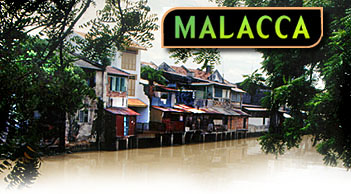
History | Attractions | Recommended
Tours

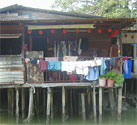 If
the ultra-modern architecture and forward-looking citizens of
Kuala Lumpur symbolize Malaysia's hopes for the future, then
the quiet, seaside city of Malacca, about 150 kilometers to the
south, is the guardian charged with the reflective task of preserving
its past. Five hundred years ago, an extraordinary empire rose
and fell here, its power and dreams suddenly caught off-gaurd
by the dawn of the Colonial Era. If
the ultra-modern architecture and forward-looking citizens of
Kuala Lumpur symbolize Malaysia's hopes for the future, then
the quiet, seaside city of Malacca, about 150 kilometers to the
south, is the guardian charged with the reflective task of preserving
its past. Five hundred years ago, an extraordinary empire rose
and fell here, its power and dreams suddenly caught off-gaurd
by the dawn of the Colonial Era.
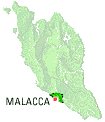 The
city was so coveted by the European powers that the Portuguese
writer Barbarosa wrote "Whoever is Lord in Malacca has his
hand on the throat of Venice." It was a major port along
the spice-route, and its harbor bristled with the sails and masts
of Chinese junks and spice-laden vessels from all over the hemisphere. Because
the city was originally built of wood, there are no crumbling
and stately reminders of the power once wielded by the Malaccan
Sultanate, but along shores of the Malacca River the scene has
probably changed little. The
city was so coveted by the European powers that the Portuguese
writer Barbarosa wrote "Whoever is Lord in Malacca has his
hand on the throat of Venice." It was a major port along
the spice-route, and its harbor bristled with the sails and masts
of Chinese junks and spice-laden vessels from all over the hemisphere. Because
the city was originally built of wood, there are no crumbling
and stately reminders of the power once wielded by the Malaccan
Sultanate, but along shores of the Malacca River the scene has
probably changed little.
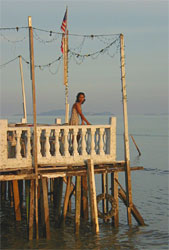
Portuguese settlement |
Sloping
rooftops of traditional Malay houses still hang over the
water, and seem to call out sleepily from the past. The
river side is a part of the city that seems to have defied
the Portuguese, who captured the city in 1511 and occupied
it for well over a century.
The Portuguese influence
is visible in the city's architecture. As they did
in other colonies, they taxed buildings relative to
their width, a policy that accounts for the deceptively
thin facades along the colonial streets. A building
no more than twelve feet across can easily extend backwards
two hundred feet, its hidden interior a linear succession
of high-ceilinged rooms and courtyards. |
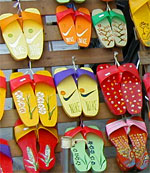 On
the streets themselves, however, it is the Chinese influence
that is felt most. As they have done for hundreds of years, Chinese
merchants advertise the wares inside their shop houses with bright
red characters. Open air fruit, vegetable, and fish markets sing
with cadences of people bargaining in Mandarin. On the edge of
the city is the largest Chinese graveyard outside of China itself,
a sprawling zone of fields, trees, and uterus-shaped tombstones.
Because of the huge cemetery and the Cheng Hoon Teng Temple (the
oldest Chinese temple in Malaysia) there is an entire industry
in Malacca that produces goods exclusively for the dead - paper
simulacra that families burn as offerings to their lost loved
ones. Because the spirits need cash in the next world, piles
of multi-colored currency with the word "Hell Note" hang
on display in what seems like every other shop. If your ghosts
like to travel, you can get them first class tickets on Hell
Airlines or, if they are Wall Street types, cellular phones and
computers. You can buy a dead person just about anything in Malacca. On
the streets themselves, however, it is the Chinese influence
that is felt most. As they have done for hundreds of years, Chinese
merchants advertise the wares inside their shop houses with bright
red characters. Open air fruit, vegetable, and fish markets sing
with cadences of people bargaining in Mandarin. On the edge of
the city is the largest Chinese graveyard outside of China itself,
a sprawling zone of fields, trees, and uterus-shaped tombstones.
Because of the huge cemetery and the Cheng Hoon Teng Temple (the
oldest Chinese temple in Malaysia) there is an entire industry
in Malacca that produces goods exclusively for the dead - paper
simulacra that families burn as offerings to their lost loved
ones. Because the spirits need cash in the next world, piles
of multi-colored currency with the word "Hell Note" hang
on display in what seems like every other shop. If your ghosts
like to travel, you can get them first class tickets on Hell
Airlines or, if they are Wall Street types, cellular phones and
computers. You can buy a dead person just about anything in Malacca.
Over the centuries, the Chinese
and local Malay cultures in Malacca intertwined, eventually producing
a completey unique society, the Baba-Nyona. This fascinating
microculture reached its height around the turn-of-the-century,
and Malacca's Baba-Nyonya Heritiage Museum preserves typical
Baba-Nyona household.
RECOMMENDED
TOURS
Explore
Malacca, Malaysia's oldest port on the "Historical
Malacca" Tour, including a visit to St. Paul's
Hill and tpo Cheng Hoon Teng, Malaysia's oldest temple.
(starting from USD $24 per person).
Geographia has partnered
with Viator to provide exciting adventure experiences in
Malaysia.
|
|
|
|